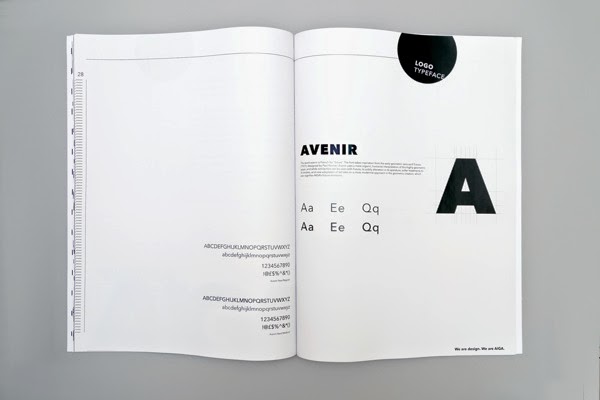I like this interesting layout for branding guidelines, it is different to most which are publications, it looks very professional, and modern, it is also interesting how the colours invert, both work very well together.
 |
| https://www.behance.net/gallery/14532271/Buero-System |
 |
| http://www.freytaganderson.com/work/adstream |
 |
| Film 4 Off Air Guidelines |
 |
| https://www.behance.net/gallery/1641514/Hello-Design-Conference-Brand-Standards-Manual |
More professional and through guidelines from Benetton: The folder even represents the brand, the green is very striking.
 |
| http://new.pentagram.com/2011/06/new-work-benetton/ |
The guidelines inside the folder are very straightforward and simple, they are very effective.
Easyjets guidelines are very true to their identity and they have covered the basics in which I can follow for my own guidelines.
 |
| Easy Jet guidelines |
Their guidelines also included 'pictures' which a few of the guidelines I looked into didn't. I think that this may be applicable to my own identity as my design contains a certain style of images,
 |
| https://www.behance.net/gallery/15145931/AIGAs-Brand-Identity-Guidelines-(school-proj) |
Further brand guidelines:
http://www.logodesignlove.com/brand-identity-style-guides
(all below from the website above)
- Adobe corporate brand guidelines (PDF)
- Alberta corporate identity manual
- Apple identity guidelines (PDF)
- Barbican identity guidelines (old)
- BASF summary of corporate design policy (PDF)
- Bath Spa University brand guidelines (PDF)
- Berkeley identity
- Best Buy brand identity
- Bitdefender brand guidelines
- Boston University brand identity standards
- Boy Scouts of America brand identity guide (PDF)
- British Council brand guidelines
- British Rail corporate identity manual
- Carnegie Mellon brand guidelines
- Channel 4 identity style guides
- Christopher Doyle identity guidelines
- Cisco logo usage and guidelines
- Code for America website style guide
- Columbia College Chicago brand identity manual
- Cornell University brand book
- Dropbox logos and branding
- Duke University style guide
- easyGroup brand manual (PDF)
- Edinburgh City brand identity guidelines (PDF)
- Esso Imperial Oil quick reference guide (PDF)
- Facebook brand assets
- Good Technology brand identity guide
- Google visual assets guidelines
- Haas School of Business identity standards style guide (PDF)
- Heineken company visual identity
- IEEE brand identity guidelines
- Jamie Oliver FRV brand guidelines
- Kew Royal Botanic Gardens brand guidelines (PDF)
- Liberty University brand identity policy
- Lloyd’s brand
- Macmillan identity guide
- MailChimp brand assets
- MasterCard brand center
- Microsoft corporate logo guidelines
- Mississauga’s Brand Story
- Mozilla Firefox branding
- NAMI identity guidelines
- National University of Singapore identity
- New York University identity and style guide
- NHS brand guidelines
- NYU-Poly identity style guide
- Ohio State University brand guidelines
- Ohio University brand standards
- Oregon State University brand identity guidelines
- Pacific University brand standards (PDF)
- Pearson logos and style guides
- Penguin logo guidelines
- Princeton University graphic identity (PDF)
- PRSA guidelines & logos
- Redfern brand identity guidelines (PDF)
- Saint Mary-of-the-Woods College style guide
- San Francisco International Airport identity program
- Santa brand book
- Skype brand book
- The Beano Comic brand guidelines (PDF)
- The Scout Association brand guidelines (PDF)
- The University of Texas brand guidelines
- Twitter brand assets and guidelines
- Ubuntu brand guidelines
- University of Arkansas graphic identity style guide
- University of California brand guidelines
- University of Cambridge identity guidelines
- University of East Anglia brand identity guidelines (PDF)
- University of Louisville brand graphics policy (PDF)
- University of Northern Colorado identity style guide (PDF)
- University of Wisconsin-Madison brand identity guidelines
- Vanderbilt University graphic standards
- Virginia Tech identity standards
- Walmart brand guidelines (PDF)
- Yale University identity guidelines
- Yelp styleguide
Brand guidelines should include most if not all of the following; (but its not limited to)
concept
logo & application
typography, number systems, leading, tracking, kerning.
colour selection
layout & grid
tone of voice
copy
Other things brand guidelines may include are:
logo & application
by-lines / straplines
product, range and distribution (methods, application)
advertising
audience
way finding
invoices and associated stationary
proposals














